| dc.contributor.author | Molska, Alicja Anna | |
| dc.contributor.author | Hill, Deborah Katherine | |
| dc.contributor.author | Andreassen, Trygve | |
| dc.contributor.author | Widerøe, Marius | |
| dc.date.accessioned | 2022-11-22T08:53:25Z | |
| dc.date.available | 2022-11-22T08:53:25Z | |
| dc.date.created | 2022-04-29T12:48:00Z | |
| dc.date.issued | 2022 | |
| dc.identifier.citation | NMR in Biomedicine. 2022, 1-15. | en_US |
| dc.identifier.issn | 0952-3480 | |
| dc.identifier.uri | https://hdl.handle.net/11250/3033277 | |
| dc.description.abstract | The aim of the current study was to establish a controlled and reproducible model to study metabolic changes during oxygen–glucose deprivation (OGD) in rat brain using a nuclear magnetic resonance (NMR)-compatible perfusion system. Rat brains were cut into 400-μm thick slices and perfused with artificial cerebrospinal fluid (aCSF) in a 10-mm NMR tube inside a 600-MHz NMR spectrometer. Four experimental conditions were tested: (1) continuous perfusion with aCSF with glucose and normoxia, and (2) 30-, (3) 60-, or (4) 120-min periods of OGD followed by reperfusion of aCSF containing glucose and normoxia. The energetic state of perfused brain slices was measured using phosphorus (31P) NMR and metabolite changes were measured using proton (1H) NMR. aCSF samples were collected every 30 min and analyzed using 1H NMR. The sample temperature was maintained at 36.7 ± 0.1°C and was checked periodically throughout the experiments. Brain slice histology was compared before and after OGD in the perfusion system using hematoxylin–eosin–saffron staining. NMR data clearly distinguished three severity groups (mild, moderate, and severe) after 30, 60, and 120 min of OGD, respectively, compared with the control group. 31P NMR spectra obtained from controls showed that phosphocreatine levels were stable for 5 h inside the perfusion system. Control 1H NMR spectra showed that lactate, N-acetylaspartic acid, glutamate, γ-aminobutyric acid, and creatine metabolite levels were stable over time, with lactate levels having a tendency to gradually increase due to the recirculation of the aCSF in the perfusion system. A controlled and reproducible perfusion system was established to study the energetic and metabolic changes in rat brain slices during and after OGD of varying severity. | en_US |
| dc.language.iso | eng | en_US |
| dc.publisher | Wiley | en_US |
| dc.rights | Attribution-NonCommercial-NoDerivatives 4.0 Internasjonal | * |
| dc.rights.uri | http://creativecommons.org/licenses/by-nc-nd/4.0/deed.no | * |
| dc.subject | rat brain slices | en_US |
| dc.subject | perfusionsystem | en_US |
| dc.subject | oxygen–glucose deprivation | en_US |
| dc.subject | hypoxic–ischemic brain injury | en_US |
| dc.subject | 31P NMR | en_US |
| dc.subject | 1H NMR | en_US |
| dc.title | Perfusion system for studying dynamic metabolomics in rat brain slices exposed to oxygen–glucose deprivation using proton and phosphorus nuclear magnetic resonance | en_US |
| dc.title.alternative | Perfusion system for studying dynamic metabolomics in rat brain slices exposed to oxygen–glucose deprivation using proton and phosphorus nuclear magnetic resonance | en_US |
| dc.type | Peer reviewed | en_US |
| dc.type | Journal article | en_US |
| dc.description.version | publishedVersion | en_US |
| dc.rights.holder | © 2022 The Authors.NMR in Biomedicinepublished by John Wiley & Sons Ltd | en_US |
| dc.source.pagenumber | 1-15 | en_US |
| dc.source.journal | NMR in Biomedicine | en_US |
| dc.identifier.doi | 10.1002/nbm.4703 | |
| dc.identifier.cristin | 2020119 | |
| cristin.ispublished | true | |
| cristin.fulltext | original | |
| cristin.qualitycode | 1 | |

